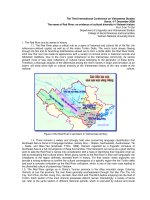GENETIC DIVERSITY IN MICROORGANISMS pptx
Bạn đang xem bản rút gọn của tài liệu. Xem và tải ngay bản đầy đủ của tài liệu tại đây (11.14 MB, 382 trang )
GENETIC DIVERSITY IN
MICROORGANISMS
Edited by Mahmut Caliskan
Genetic Diversity in Microorganisms
Edited by Mahmut Caliskan
Published by InTech
Janeza Trdine 9, 51000 Rijeka, Croatia
Copyright © 2012 InTech
All chapters are Open Access distributed under the Creative Commons Attribution 3.0
license, which allows users to download, copy and build upon published articles even for
commercial purposes, as long as the author and publisher are properly credited, which
ensures maximum dissemination and a wider impact of our publications. After this work
has been published by InTech, authors have the right to republish it, in whole or part, in
any publication of which they are the author, and to make other personal use of the
work. Any republication, referencing or personal use of the work must explicitly identify
the original source.
As for readers, this license allows users to download, copy and build upon published
chapters even for commercial purposes, as long as the author and publisher are properly
credited, which ensures maximum dissemination and a wider impact of our publications.
Notice
Statements and opinions expressed in the chapters are these of the individual contributors
and not necessarily those of the editors or publisher. No responsibility is accepted for the
accuracy of information contained in the published chapters. The publisher assumes no
responsibility for any damage or injury to persons or property arising out of the use of any
materials, instructions, methods or ideas contained in the book.
Publishing Process Manager Marina Jozipovic
Technical Editor Teodora Smiljanic
Cover Designer InTech Design Team
First published February, 2012
Printed in Croatia
A free online edition of this book is available at www.intechopen.com
Additional hard copies can be obtained from
Genetic Diversity in Microorganisms, Edited by Mahmut Caliskan
p. cm.
ISBN 978-953-51-0064-5
Contents
Preface IX
Part 1 Microbial Genetic Diversity 1
Chapter 1 Diversity of Heterolobosea 3
Tomáš Pánek and Ivan Čepička
Chapter 2 Archaeal Diversity and Their
Biotechnological Potential 27
Birgül Özcan
Chapter 3 Genotyping Techniques for Determining
the Diversity of Microorganisms 53
Katarzyna Wolska and Piotr Szweda
Chapter 4 DNA Based Techniques for
Studying Genetic Diversity 95
Ahmed L. Abdel-Mawgood
Chapter 5 Patterns of Microbial Genetic Diversity and
the Correlation Between Bacterial
Demographic History and Geohistory 123
Pei-Chun Liao and Shong Huang
Chapter 6 Microsatellites as Tools for
Genetic Diversity Analysis 149
Andrea Akemi Hoshino, Juliana Pereira Bravo,
Paula Macedo Nobile and Karina Alessandra Morelli
Chapter 7 HIV-1 Diversity and Its Implications
in Diagnosis, Transmission,
Disease Progression, and
Antiretroviral Therapy 171
Inês Bártolo and Nuno Taveira
VI Contents
Chapter 8 Using Retroviral Iterative Genetic Algorithm to Solve
Constraint Global Optimization Problems 215
Renato Simões Moreira, Otávio Noura Teixeira,
Walter Avelino da Luz Lobato, Hitoshi Seki Yanaguibashi
and Roberto Célio Limão de Oliveira
Part 2 Phylogenetics 233
Chapter 9 Genetically Related Listeria Monocytogenes
Strains Isolated from Lethal Human
Cases and Wild Animals 235
Ruslan Adgamov, Elena Zaytseva, Jean-Michel Thiberge,
Sylvain Brisse and Svetlana Ermolaeva
Chapter 10 Issues Associated with Genetic Diversity
Studies of the Liver Fluke, Fasciola Heptica
(Platyhelminthes, Digenea, Fasciolidae) 251
Denitsa Teofanova, Peter Hristov,
Aneliya Yoveva and Georgi Radoslavov
Chapter 11 Genetic Diversity of Brazilian Cyanobacteria
Revealed by Phylogenetic Analysis 275
Maria do Carmo Bittencourt-Oliveira
and Viviane Piccin-Santos
Chapter 12 Pre-Columbian Male Ancestors for
the American Continent, Molecular
Y-Chromosome Insight 291
Graciela Bailliet, Marina Muzzio, Virginia Ramallo,
Laura S. Jurado Medina, Emma L. Alfaro,
José E. Dipierri and Claudio M. Bravi
Chapter 13 Approaches for Dissection of the
Genetic Basis of Complex Disease
Development in Humans 309
Nicole J. Lake, Kiymet Bozaoglu,
Abdul W. Khan and Jeremy B. M. Jowett
Chapter 14 Genetic Diversity and the Human
Immunodeficiency Virus Type-1:
Implications and Impact 339
Orville Heslop
Preface
So far as we know all life in the universe exists at or near the surface of planet Earth.
The life forms on Earth connected through shared history are a DNA-based life.
Reconstruction of this history, known as phylogeny, is one of the most difficult
challenges in contemporary biology. However it is well worth the effort, because of
the considerable benefits that robust phylogenetic hypotheses can provide for
diverse fields of biology, both basic and applied. Because even distantly related life
forms are perfectly similar genetically and share the same regulatory genes, it would
be counterproductive not to take advantage of the full range of variation produced
by this great experiment conducted over billions of years. Robust phylogenetic trees
are essential tools for displaying this variation efficiently. Genetics, the science of
heredity, deals with the factors that are responsible for the similarities and
differences between life forms and generations. These factors affect form and
function at every level, from the molecules that compose each living cell, through
the organismal and population levels of biological organization. The concepts of
genetics are therefore fundamental to all biological disciplines and serve as the
unifying core in the study of modern biology.
Biological evolution is the dual process of genetic change and diversification of
organisms through time. By this process related populations can diverge from one
another in their genetic characteristics and give rise to new species. The idea that
populations can change over time and produce different species, and that all present
day species (approximately 2100 million species) were derived in this manner from a
common ancestor, provides a rational framework for organizing the vast array of
biological knowledge. Through evolution, new species arise through the process of
speciation. New varieties of organisms arise and thrive when they have the ability to
find and exploit an ecological niche, however, species become extinct when they are
no longer able to survive in changing conditions or against superior competition. Most
of extinctions have occurred naturally and it is estimated that 99.9% of all species that
have ever existed are now extinct. Mass extinctions are relatively rare events.
However, isolated extinctions are quite common and scientists have become alarmed
at the high rates of recent extinctions. Most species that become extinct are never
scientifically documented. Some scientists estimate that up to half of presently existing
X Preface
species may become extinct by 2100. Genetic diversity is required for populations to
evolve and cope with environmental changes, new diseases, and pest epidemics.
Genetic variability also provides the opportunity for tracing the history of populations,
species, and their ancestors. Therefore, the assessment of genetic variation in species
and among populations is important for conservation of genetic resources. The genetic
diversity determination can be based on morphological, biochemical, and molecular
types of data. As a matter of fact, molecular markers (RFLP, RAPD, mtDNA, RFLP,
SNP etc.) are superior to both morphological and biochemical markers because they
are relatively simple to detect, abundant throughout the genome, completely
independent of environmental conditions, and can be detected at virtually any stage of
development.
Genetic diversity is the fundamental source of biodiversity. In 1989, the World Wildlife
Fund defined biodiversity as “the richness of life on Earth – millions of plants, animals
and microorganisms, including the genes which they carry, and complex ecosystems
that create the environment”. Currently, the issue of maintaining the genetic diversity
as a component of the conservation of biodiversity has been accepted at an
international level. FAO has included the issue of conservation, evaluation, and use of
animal genetic resources, in its fields of interest since 1970s. In this context, one of the
main concerns of scientific research activities is conserving the genetic diversity of
local breeds, especially those of economic interest. Genetic diversity among
individuals reflects the presence of different alleles in the gene pool, and hence,
different genotypes within populations. Genetic diversity should be distinguished
from genetic variability, which describes the tendency of genetic traits found within
populations to vary. There is a considerable genetic variability within or between
natural populations. Population geneticists attempt to determine the extent of this
variability by identifying the alleles at each locus and measuring their respective
frequencies. This variability provides a genomic flexibility that can be used as a raw
material for adaptation. On the other hand, one of the consequences of low genetic
variability could be inability to cope with abiotic and biotic stresses. From the growing
knowledge on the genome sequences of organisms it becomes evident that all forms of
diversity have their origin at genetic level. In this context genetic diversity analysis
provides vital and powerful data that helps for better understanding of genetic
variation and improved conservation strategies.
The purpose of these books is to provide a glimpse into the dynamic process of genetic
variation by presenting the thoughts of some of the scientists who are engaged in
development of new tools and ideas used to reveal genetic variation, often from very
different perspectives. These books should prove useful to students, researchers, and
experts in the area of conservation biology, genetic diversity, and molecular biology.
The year 2010 has been celebrated as the international year of biodiversity by the
United Nations and it has been a unique opportunity to realize the vital role that
Preface XI
biodiversity plays in sustaining the life on Earth. Let us all wish much success to all
projects and initiatives dealing with the conservation of diversity of life because rich
genetic resources are a prerequisite for future generations to be able to breed crop
varieties and face new challenges.
Mahmut Caliskan
Mustafa Kemal University,
Department of Biology, Hatay,
Turkey
Part 1
Microbial Genetic Diversity









